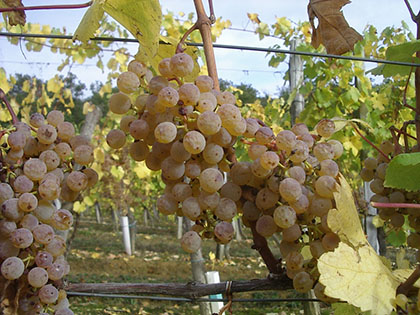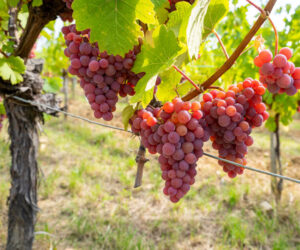
Petit Manseng is a white grape, with small loose clusters and small thick-skinned berries. It also shows considerable resistance to Botrytis bunch rot because of its cluster morphology. The traditional wines made from Petit Manseng are sweet and aromatic. It is rare that they are made into varietal wines, instead most often being blended with the other local indigenous varieties. To make this style, the clusters are hung on the vine until November or December, concentrating the sugars and aromatic flavors even more. The acidity helps retain its structure in the mouth. It seems in the Old World, this is a local style sought after as I have experienced this in other departments of France.
The first mention of it in a text was in 1562 in Jurançon, a department in southwestern France. This mention is not clear whether it referred to Gros Manseng or to Petit Manseng. The Manseng family was viticulturally suited for the region, being an early budding variety that retains its acidity while accumulating sugars during the growing season. The Manseng family was not really distinguished between Petit and Gros until 1783–1784. More recent DNA parentage analysis suggests that it is the progeny of Savagnin and a parent of Gros Menseng.
Today, Petit Manseng is still the principle variety in the Jurançon and Pacherenc du Vic-Bilh appellations and has spilled over into the Languedoc due to its increasing popularity. Renowned wine author Jancis Robinson writes that it has potential over the border in northeastern Spain, but only about 10 acres are planted there.
Grape varieties made it to the New World largely because the people who brought them here were bringing what they were familiar with. Beyond its traditional home in southwestern France, when the Basque people immigrated to Uruguay in the 1870s they brought their little piece of their ancestral home with them, which is thought to be Petit Manseng’s first introduction into the New World.
In contrast, I am glad that today’s winemakers and viticulturists are discovering that these ancestral varieties can thrive in areas outside of their traditional regions. From a viticultural standpoint, planting based on a variety’s performance in the local micro-climate is enormously important in the maturation of the grapes within each season. Also, planting varieties suited for the region that are resistant to the local disease pressures result in far fewer chemicals that need to be applied to the vines. While Chardonnay and Cabernet Sauvignon are still the dominant varieties in Virginia and south to Georgia, Petit Manseng is becoming increasingly popular due to its viticultural characteristics and ability to thrive in the high humidity experienced there.
Good quality fruit translates to good quality wine, and winemakers have seized on this. In Virginia alone, where a mere 65 acres were reported growing in 2012, Petit Manseng is enjoying an annual increase in acreage, and 75 acres were reported in 2014, with an additional 31 non-bearing acres reported to come in 2015. Very little Petit Manseng is grown in California; Tablas Creek Winery on the central coast produces the varietal (and you can read more about this wine from their winemaker, Neil Collins, in this “Tips from the Pros”), but statewide acreage is not even enough to be included in the annual grape report or crush statistics released by the US Department of Agriculture.
While the traditional wines of Petit Manseng were sweet, it can turn out to make a nice dry wine as well (for which I have provided a recipe for at the end of this column). The drier styles can be likened to Rieslings or Gewürztraminers. With any higher acid grape, the winemaker needs to focus on the right balance of acidity in the wine. Acidity is important in that it adds structure to the wine, and higher acidity is generally correlated with lower pH, which contributes to microbial stability. The winemaker’s challenge is that too much acidity can lead to perceived bitterness in the resulting wine, necessitating the consideration for a de-acidification. The first option that comes to mind to address this is putting the wine through a malolactic fermentation, but if the pH is too low this may be a difficult process for the bacteria. The aforementioned Tablas Creek wine lists a pH of 3.01 — much like the Muscadets of France’s Loire Valley. Winemakers there stir the lees, which helps move the process along. Another technique is to balance the acidity on the palate with residual sugar.
Achieving the balance takes a little forethought and can come about via careful tasting towards the end of the fermentation and arresting the fermentation when the right balance is achieved, or by fermenting two tanks and arresting the fermentation in one early for a dessert style, and letting the other go dry. Careful back blending the sweeter wine into the dry wine through bench trials will dial in your final blend. Always a concern when bottling a sweet wine is the possibility of a re-fermentation in the bottle. Re-fermentation can be avoided by sterile filtration of the final blend at bottling.
With its roots in France, there has to be a gastronomic component to Petit Manseng that needs mention. My first experience with it was at a dinner party hosted by a French colleague of mine who had just returned from his family’s village. Along the way, he had also acquired some foie gras and a fruit chutney, and what a lovely appetizer for dinner we had. Sweeter versions can also pair well with spicy dishes and this might be something a French-Asian fusion chef would want to experiment with.
Winemaking is blending. We blend multiple wines so that the sum is greater than the parts and the best components of each can benefit the resulting blended wine. It is interesting that the same conceptual idea can be applied to the Old World and New World viticulture and winemaking production techniques employed for Petit Manseng. From what I have tasted of the Old World, and also of the New World, I feel that those “explorers” who really wanted something in Petit Manseng as an emerging variety in the New World went back to the Old World for the knowledge base to step it up a notch. They didn’t know what they were going to get unless they tried it. They got something that is different and stands out from the rest and in the hopes that it will catch on, their dream of “One World” with Petit Manseng lives strong amongst them.
Recipe
Ingredients
• 100 lbs. (45 kg) Petit Manseng
• Distilled water
• 10% potassium metabisulfite (KMBS) solution. Weigh 10 grams of KMBS, dissolve into about 75 milliliters (mL) of distilled water. When completely dissolved, make up to 100 mL total with distilled water.
• 5 grams Zymaflor VL3 or Anchor VIN13 yeast (Lallemand QA23 can also be used as a substitute)
• 5 grams Fermaid K (or equivalent yeast nutrient)
• 5 grams di-ammonium phosphate (DAP)
• Rice hulls
Other Equipment or Needs
• Food-grade plastic tub (about 18 gallons/68 L)
• 5-gallon (19-L) carboy
• 6-gallon (23-L) carboy
• 6-gallon (23-L) plastic bucket
• Destemmer/crusher
• Basket press
• Airlock/stopper
• Racking hoses
• Equipment cleaning and sanitizing agents (Bio-Clean, Bio-San)
• Inert gas (nitrogen, argon, or carbon dioxide)
• Refrigerator (~45 °F/7 °C) (Remove the shelves so that the bucket will fit.)
• Ability to maintain a fermentation temperature of 55 °F (13 °C). TIP: Use a 33-gallon (125-L) plastic can as a water bath. Place ice blocks in the water to maintain a relatively constant temperature. This will be your refrigeration system for peak fermentation. If you have other means to keep things cool, of course use that. Alternatively, if you may have a need to keep it warm, wrapping the bucket/carboy with an electric carboy wrap (available at most winemaking retailers) works well. Thermometer capable of measuring between 40–110 °F (4–43 °C) in one degree increments
• Pipettes with the ability to add in increments of 1 mL
Step by step
1. Crush and press the grapes to the large tub.
2. Estimate the volume of the must and mix in the rice hulls to equal about 30% of the total volume.
3. Move the must/rice hull slurry directly to the press and press to the 6-gallon (23-L) bucket. The rice hulls aid in pressing by creating juice channels. Your juice yields will increase significantly with their use.
4. While pressing the must to a 6-gallon (23-L) bucket, add 16 mL of 10% KMBS solution (This addition is the equivalent of 40 mg/L (ppm) SO2). Layer the headspace with inert gas and keep covered.
5. Move the juice to the refrigerator and let settle at least overnight.
6. When sufficiently settled, rack the juice off of the solids into the 6-gallon (23-L) carboy.
7. Prepare yeast. Heat about 50 mL distilled water to 104 °F (42 °C). Sprinkle the yeast on the surface of the water and gently mix so that no clumps exist. Let sit for 15 minutes undisturbed. Measure the temperature of the yeast suspension and the juice. You do not want to add the yeast to your cool juice if the difference in temperatures of the yeast and must exceeds 15 °F (8 °C). To avoid temperature shock, acclimate your yeast by taking about 10 mL of the juice and adding it to the yeast suspension. Wait 15 minutes and measure the temperature again. Do this until you are within the specified temperature range. Do not let the yeast sit in the original water suspension for longer than 20 minutes. When the yeast is ready, add it to the fermenter.
8. Add Fermaid K or equivalent yeast nutrient and stir thoroughly.
9. Initiate the fermentation at room temperature, about 65–68 °F (18–20 °C). Once fermentation is noticed, (usually at around 24 hours) move to a location where the temperature can be maintained at 55 °F (13 °C).
10. Two days after fermentation starts, dissolve the DAP in as little distilled water required to completely go into solution (~20 mL). Add directly to the carboy and stir thoroughly.
11. Normally you would monitor the progress of the fermentation by measuring Brix. One of the biggest problems with making white wine at home is maintaining a clean fermentation. Entering the carboy to measure the sugar is a prime way to infect the fermentation with undesirable microbes. So at this point, the presence of noticeable fermentation is good enough. If your airlock becomes dirty by foaming over, remove, clean, and replace it as quickly and cleanly as possible. Sanitize anything that will come in contact with the fermenting juice.
12. Leave alone until bubbles in the airlock are about one bubble per minute (about two to three weeks).
13. Measure the Brix. The wine is considered dry, or nearly dry when the Brix reaches negative 1.5 °Brix or less.
14. When the fermentation is complete, add 15 mL of fresh KMBS (10%) solution.
15. Transfer the wine off of the lees to the 5-gallon (19-L) carboy and lower the temperature to 38–40 °F (3–4 °C). Make sure there is no headspace. Fill the 5-gallon (19-L) carboy to the top.
16. After two weeks, test for pH and SO2 and adjust as necessary to attain 0.8 ppm molecular SO2.
(You can find a simple SO2 calculator that can help at www.winemakermag.com/guide/sulfite). Check the SO2 in another two weeks, prior to the next racking and adjust while racking. Once the free SO2 is adjusted, maintain at the target level by monitoring every 3–4 weeks.
17. Filter the wine as necessary prior to bottling.
18. At about three months you are ready to bottle. Check and adjust SO2 before bottling, if necessary. Be sure to maintain sanitary conditions while bottling. Once bottled, you’ll need to periodically check your work by opening a bottle to enjoy with friends.




